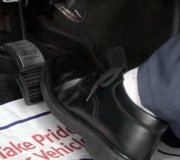Welcome to 2CarPros.
First, make sure the brake fluid in the master cylinder reservoir is full and not empty. If it is empty, check under the vehicle for evidence of a leak.
If the MC is full, then I suspect the MC has gone bad and will need replacement. Take a look through this link:
https://www.2carpros.com/articles/brake-pedal-goes-to-the-floor
If you determine the MC is the issue, here is a link that shows in general how one is replaced:
https://www.2carpros.com/articles/how-to-replace-a-brake-master-cylinder
Here are the directions specific to your vehicle. The attached picture correlates with the directions.
__________________________________
2000 Honda Civic DX Sedan L4-1590cc 1.6L SOHC MFI
Removal/Installation
Vehicle Brakes and Traction Control Hydraulic System Brake Master Cylinder Service and Repair Procedures Removal/Installation
REMOVAL/INSTALLATION
pic 1
CAUTION:
- Be careful not to bend or damage the brake lines when removing the master cylinder.
- Do not spill brake fluid on the vehicle; it may damage the paint; if brake fluid does contact the paint, wash it off immediately with water.
- To prevent spills, cover the hose joints with rags or shop towels.
1. Disconnect the brake fluid level switch connectors.
2. Remove the reservoir cap from the master cylinder.
3. The brake fluid may be sucked out through the top of the master cylinder reservoir with a syringe.
4. Disconnect the brake lines from the master cylinder.
5. Remove the master cylinder mounting nuts and washers.
6. Remove the master cylinder from the brake booster.
7. Disconnect the vacuum hose from the brake booster.
8. Remove the cotter pin and clevis pin from the clevis.
CAUTION: Do not disconnect the clevis by removing it from the operating rod of the brake booster. If the clevis is loosened, adjust the pushrod length before installing the brake booster.
9. Remove the four booster mounting nuts.
10. Pull the brake booster forward until the clevis is clear of the bulkhead.
11. Remove the brake booster from the engine compartment.
12. Install the brake booster and master cylinder in the reverse order of removal.
CAUTION:
- When connecting the brake lines, make sure that there is no interference between the brake lines and other parts.
- Be careful not to bend or damage the brake lines when installing the master cylinder.
NOTE: If replacing the master cylinder or brake booster, check and adjust the pushrod clearance before installing the master cylinder.
13. Fill the master cylinder reservoir, and bleed the brake system.
14. After installation, check the brake pedal height and brake pedal free play and adjust if necessary.
____________________________________
Let me know if this helps or if you have other questions.
Take care,
Joe
Image (Click to make bigger)
Tuesday, March 16th, 2021 AT 11:44 AM




